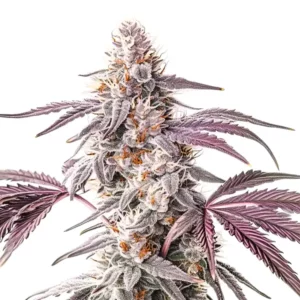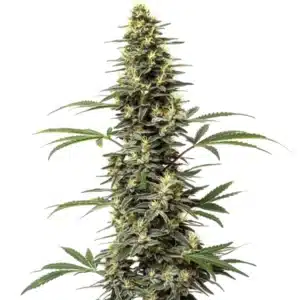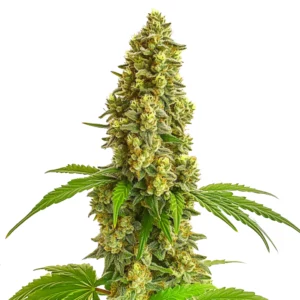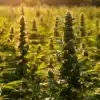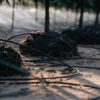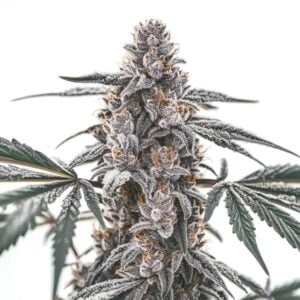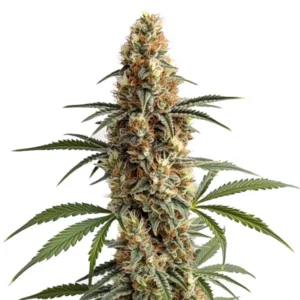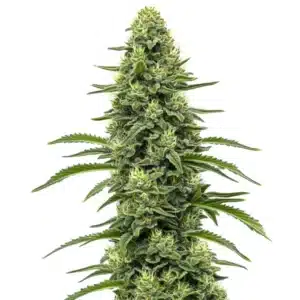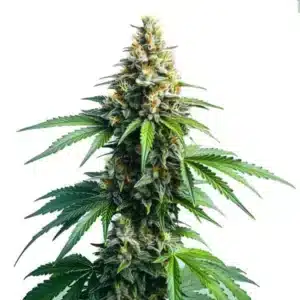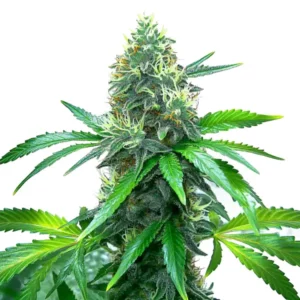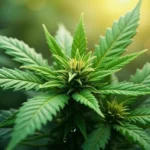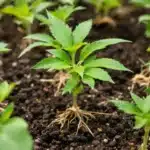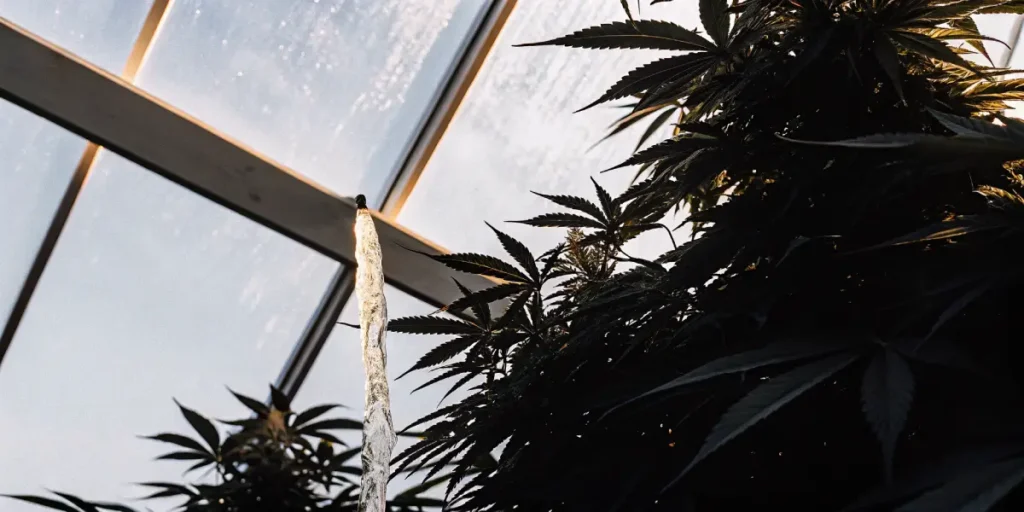
Cannabis Latex vs Sap: What’s the Difference?
When delving into the world of cannabis cultivation, one may encounter the terms cannabis latex and sap. Understanding cannabis latex vs sap is important because, while both substances are secretions from the cannabis plant, they have distinct properties and uses. Cannabis latex is a milky, sticky substance produced by the plant as a protective measure. On the other hand, sap is a more fluid, water-like secretion that mainly functions in nutrient transport.
For new growers or those considering buying seeds, it’s essential to understand these differences. Knowing whether you’re dealing with latex or sap can help in identifying plant health issues or determining the best time for harvesting. As you cultivate your cannabis crop, such as the high-yielding Blue Dream, you’ll notice these secretions at different growth stages.
Recommended Strains
Blue Dream
|
|
THC | 17% - 24% (Medium) |
|
|
Type | Feminized |
|
|
Yield | High |
|
|
Phenotype | 50% Indica / 50% Sativa |
GG4
|
|
THC | 27% (High) |
|
|
Type | Feminized |
|
|
Yield | High |
|
|
Phenotype | 40% Indica / 60% Sativa |
For experienced growers, the debate between cannabis latex vs sap can influence cultivation techniques and harvest quality. It’s not just about choosing the right seeds but knowing how to care for the plant throughout its lifecycle. This knowing can lead to a healthier, more productive garden, whether you’re growing the resilient Gorilla Glue 4 or another strain.
Differences Between Cannabis Latex and Sap
When comparing cannabis latex versus sap differences, the most crucial distinction lies in their composition and function. Latex is primarily composed of a complex mixture of alkaloids, terpenes, and other compounds. This sticky substance acts as a deterrent to herbivores and pests. Sap, however, is a nutrient-rich fluid that plays a vital role in transporting essential nutrients throughout the plant.
Knowing these differences is key to effective cultivation. For instance, if you spot latex oozing from your plant, it might indicate a pest issue that needs addressing. Conversely, the presence of sap is generally a sign of a healthy plant. This knowledge is particularly useful when growing strains like Black Widow, which can be sensitive to environmental changes.
The cannabis plant latex and sap comparison is not only about knowing their physical characteristics but also about recognizing their roles in plant development. By discerning these cannabis latex versus sap differences, growers can better tailor their care strategies to enhance plant resilience and productivity. This differentiation also aids in selecting appropriate cultivation practices that align with the plant’s natural processes, ultimately leading to more successful harvests.
Additionally, recognizing the cannabis latex versus sap differences can help prevent common cultivation mistakes. For example, misinterpreting sap as a sign of distress could lead to unnecessary interventions, while correctly identifying latex can prompt timely pest management. Thus, a comprehensive knowing of these substances is indispensable for both novice and seasoned cultivators aiming for optimal plant health and yield outcomes.
Benefits of Cannabis Latex vs Sap
Both cannabis latex and sap offer unique benefits to growers. The benefits of cannabis latex vs sap largely depend on how you intend to use the plant. Latex, with its protective properties, can naturally shield the plant from unwanted pests. This can reduce the need for chemical pesticides, making your crop more organic.
Sap’s benefits are more internal. By facilitating nutrient transport, it supports overall plant health and growth. A well-fed plant is a productive one, and knowing sap flow can help you optimize feeding schedules. For growers of Gelato, ensuring the sap flow is unhindered can enhance bud quality.
The benefits of cannabis latex vs sap also extend to their impact on the surrounding ecosystem. Latex can act as a protective barrier not only for the cannabis plant itself but also for neighboring plants by deterring common pests. This symbiotic benefit can foster a healthier garden environment, reducing the need for external pest control methods that might harm beneficial insects.
Conversely, the benefits of sap include its role in promoting vigorous plant growth and development. By maintaining healthy sap production, growers can ensure that their plants receive the necessary nutrients to thrive in various environmental conditions. This balance of nutrient flow is crucial for achieving maximum yield potential and ensuring that the plant remains resilient against environmental stressors.
Promos & Deals
How to Extract Cannabis Latex and Sap
Extracting cannabis latex and sap requires careful handling. To extract latex, you can gently score the plant’s surface, allowing the milky substance to ooze out. Collecting latex is often done when the plant is mature but before any significant damage occurs.
Extracting sap is a bit more involved. It typically involves trimming or pruning, which naturally releases sap. This is usually done during the vegetative stage when sap flow is at its peak. Remember, the method of extraction can impact the plant’s health, so always use sterilized tools.
When considering how to extract cannabis latex and sap, it’s crucial to approach the process with precision to avoid harming the plant. Using sharp, clean instruments minimizes the risk of introducing infections or causing undue stress to the plant. For latex, controlled scoring should be done selectively to maintain plant integrity while harvesting the desired secretion.
In contrast, when learning how to extract cannabis latex and sap, sap extraction should be aligned with routine maintenance activities like pruning. This approach not only facilitates the collection of sap but also promotes healthy plant architecture and growth. Both methods require a keen knowing of the plant’s life cycle to optimize the timing and technique of extraction.
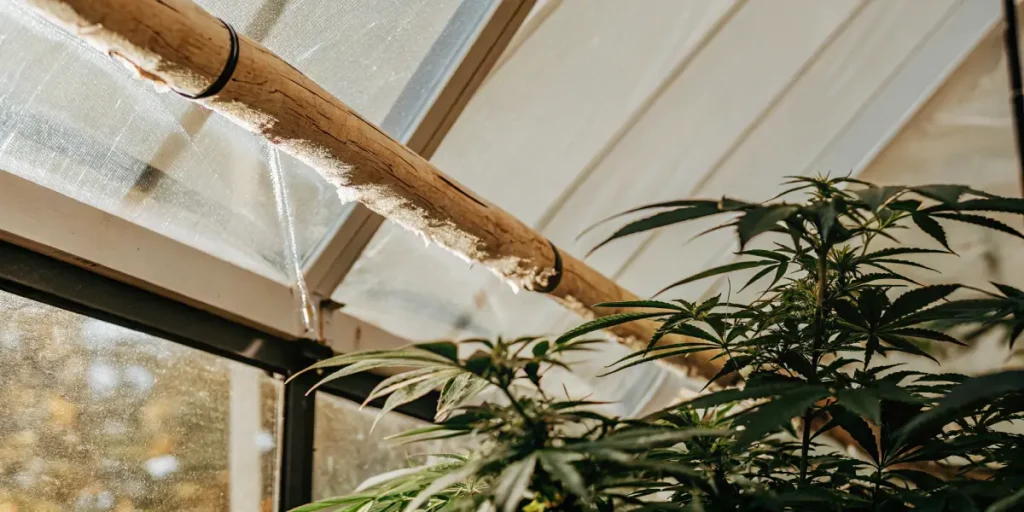
Uses of Cannabis Latex Compared to Sap
Uses of cannabis latex compared to sap vary significantly. Latex is often used for its protective qualities. Some growers apply it back onto the plant or surrounding vegetation to deter pests naturally. This can be a cost-effective solution for organic growers.
Sap, in contrast, is less about external application and more about internal plant health. Knowing sap flow can help inform irrigation practices. By ensuring that the plant has a steady flow of nutrients, growers can improve the health and yield of their crop.
The uses of cannabis latex compared to sap also highlight the diverse strategies available to growers in managing their cannabis crops. Latex can be harnessed as a natural pesticide, offering a sustainable alternative to chemical solutions in organic farming practices. This application not only protects the plant but also supports broader ecological balance by minimizing chemical runoff.
In examining the uses of cannabis latex compared to sap, sap’s role in internal plant health cannot be overstated. By optimizing sap flow, growers can ensure that nutrient delivery is efficient, which is critical for robust plant development and maximizing yield. This internal focus complements the external protective role of latex, showcasing a holistic approach to cannabis cultivation that leverages both secretions for optimal results.
FAQs: Cannabis Latex vs Sap
What are the main differences between cannabis latex and sap?
The primary difference between cannabis latex and sap lies in their function and composition. Cannabis latex is a sticky, protective substance rich in compounds that deter pests. Sap, however, is a nutrient-rich fluid essential for transporting nutrients throughout the plant.
While both are secretions from the cannabis plant, they serve different purposes. Recognizing these differences can aid in diagnosing plant health and optimizing cultivation practices. For instance, excessive latex may indicate pest issues, while healthy sap flow is a sign of a thriving plant.
In the cannabis plant latex and sap comparison, knowing these fundamental differences is crucial for implementing effective cultivation strategies. By recognizing the distinct roles of latex and sap, cultivators can tailor their approaches to better support the plant’s natural defenses and growth processes. This knowledge is instrumental in addressing specific plant needs and enhancing overall garden productivity.
Additionally, the cannabis plant latex and sap comparison serves as a guide for troubleshooting common cultivation challenges. For example, identifying latex production can prompt timely pest management interventions, while monitoring sap can offer insights into the plant’s nutritional status. This differentiation supports informed decision-making throughout the growing cycle.
Can cannabis latex and sap be used interchangeably?
No, cannabis latex and sap cannot be used interchangeably due to their distinct functions. Latex is primarily for external protection against pests, while sap is crucial for internal nutrient transport. Each serves a unique role in supporting plant health.
Attempting to use them interchangeably could disrupt the plant’s natural processes. For example, focusing solely on latex for pest control might neglect the nutritional needs addressed by sap. Both should be considered in a balanced cultivation approach.
The cannabis plant latex and sap comparison underscores the importance of recognizing their complementary roles within the plant’s ecosystem. Using them interchangeably could inadvertently compromise plant health, as each secretion supports different but equally vital functions. This knowing is essential for cultivating a thriving cannabis garden.
Moreover, the distinct uses of cannabis latex compared to sap emphasize the need for strategic management of each substance. By respecting their unique properties and functions, growers can ensure that both latex and sap contribute effectively to the plant’s overall health and productivity, leading to a more successful cultivation outcome.
How can I tell if my cannabis plant is producing latex or sap?
To determine if your cannabis plant is producing latex or sap, observe the consistency and location of the secretion. Latex is usually sticky and white, found on the plant’s surface. It often appears when the plant is stressed or damaged.
Sap, on the other hand, is clear and more fluid-like, often seen when branches are pruned. Regular observation and knowing the plant’s growth stage can help you identify which substance is being produced.
Accurate identification in the cannabis plant latex and sap comparison is crucial for making informed cultivation decisions. Observing the plant’s response to environmental conditions and stressors can provide additional clues. For instance, if latex appears without apparent injury, it may signal underlying pest pressure, whereas consistent sap flow suggests robust nutrient circulation.
Developing a keen eye for recognizing these secretions can significantly enhance your ability to manage plant health effectively. By distinguishing between latex and sap, growers can implement targeted interventions and optimize their cultivation techniques, ultimately supporting a more resilient and productive cannabis garden.
Are there specific cannabis strains that produce more latex or sap?
Some cannabis strains are naturally inclined to produce more latex or sap. For example, strains with robust pest resistance, like Blue Dream, might produce more latex. This helps them ward off pests more effectively.
On the other hand, high-yield strains like Gelato might have a more pronounced sap flow to support their growth. Choosing the right strain can depend on your cultivation needs and environmental conditions.
Knowing cannabis latex versus sap differences in various strains can guide growers in selecting the most suitable genetics for their specific cultivation goals. Strains known for higher latex production can offer enhanced pest resistance, making them ideal for environments where pest pressure is a significant concern.
Conversely, strains with increased sap flow capacity may be better suited for growers aiming for high yields and robust plant development. This cannabis plant latex and sap comparison can inform strain selection and cultivation strategies, ensuring that growers achieve their desired outcomes while maintaining plant health and vigor.
What are the best practices for managing cannabis latex and sap?
Managing cannabis latex and sap involves regular monitoring and maintenance. For latex, ensure the plant isn’t overly stressed, which could lead to excessive production. Regular pest checks and balanced nutrition can help manage latex levels.
For sap management, focus on consistent watering and nutrient supply. Pruning should be done carefully to avoid excessive sap loss. By maintaining a balance, you can support the plant’s health and maximize yield.
Implementing best practices for cannabis latex vs sap management can significantly enhance plant health and productivity. For latex, promoting environmental stability and reducing stressors can prevent excessive secretion, while routine pest monitoring ensures timely interventions when needed.
For sap management, optimizing irrigation and nutrient delivery is crucial. Knowing the plant’s growth stage and adjusting care practices accordingly can help maintain healthy sap flow. This comprehensive approach to managing cannabis latex and sap supports a balanced cultivation environment conducive to achieving optimal yield and quality.




